SCERT AP Board 10th Class Social Solutions 12th Lesson Sustainable Development with Equity Textbook Questions and Answers.
AP State Syllabus SSC 10th Class Social Studies Solutions 12th Lesson Sustainable Development with Equity
10th Class Social Studies 12th Lesson Sustainable Development with Equity Textbook Questions and Answers
Improve your learning
Question 1.
Identify at least ten food items that you consume and find out how far they have travelled from their place of production to reach your plate.
 Many people have argued for localisation of food production rather than food travelling long distances. How is localisation of food connected to the environment ? Find out more about the localisation movement in food and organise a discussion and debate in the classroom.
Many people have argued for localisation of food production rather than food travelling long distances. How is localisation of food connected to the environment ? Find out more about the localisation movement in food and organise a discussion and debate in the classroom.
Answer:

![]()
Question 2.
Why did the people of Jalsindhi village refuse to move out of the village?
Answer:
- The people of Jalsindhi were asked to leave the place as it would be the first village in Madhya Pradesh to be submerged by Sardar Sarovar dam.
- They have lived there for generations, cleared the forests, worshipped Gods, improved the soil, domesticated animals and settled in villages.
- In hard times they went to the forest and used its produce.
- They live with their clan, their relatives.
- They are all alike and they share a common understanding.
- Their village gods were all there.
- The land in Gujarat was not acceptable to them.
- The compensation to be given by Madhya Pradesh government was not acceptable to them.
- They were born from the belly of the Narmada and they were not afraid to die in her lap.
- That’s why they were not ready to leave their village.
Question 3.
“This is the land of our forefathers. We have a right to it. If this is lost, then we will only get spades and pickaxes, nothing else ” says Bava Mahalia. Can you explain the statement?
Answer:
- Bava Mahaliya belonged to Jalsindhi, a village on the banks of river Narmada.
- When government decided to construct Sardar Sarovar dam, it would be the first village in Madhya Pradesh to be submerged.
- They lived there for generations.
- Their ancestors cleared the forest, worshipped Gods, improved the soil, domesticated the animals and settled in villages.
- They had flowing water of the river Narmada and fodder in the forest.
- In hard times they depended on forest produce.
- Their children played on the banks of the river Narmada.
- They were all alike there and shared a common understanding.
- Thus, they say that was their forefathers’ land and they won’t leave it. They will try to protect it by hook or crook.
![]()
Question 4.
“Last, but not the least, the key to the environmental problem lies in changing lifestyles that will minimise waste and pollution.”
(i) What are the various ways in which our lifestyles affect the environment? Use examples from your own context to explain.
Answer:
- There are various ways in which our lifestyles affect the environment.
- Nowadays people are using polythene covers as carry bags for almost every household chore.
- After usage they are thrown into waste.
- It takes many years for them to completely decay into land.
- Everyone is using vehicles to travel, they emit carbon monoxide and a few other gases which cause damage to environment.
- The usage of air-conditioners and refrigerators is also increasing, the gases emitted by them cause the destruction or holes to ozone layer.
- Thus, our lifestyle is the key to environmental problems.
- So we need to change our lifestyle and minimize the waste and reduce the pollution.
(ii) Find out about the various ways in which the problems of garbage and emissions are being dealt with around the world.
Answer:
- The problems of garbage and emissions are dealt In i
- The garbage is divided into dry waste and wet waste and thus channelized to be used In production of electricity.
- Much research is underway in waste management.
- United Nations organs are working on the emission of gases and their management.
- Euro standards were set up and the production of vehicles also was made compatible.
- In many places conversion from the usage of petroleum or diesel to Natural Gas Compressed (CNG) was also advocated.
- Making products that are more durable, repairable, re-usable and recyclable would help out down on the amount of waste being created.
- Encouraging people and business to re-use goods via charity shops or other re-use networks would help boost markets for second hand items.
![]()
Question 5.
Rapid extraction of minerals and other natural resources would adversely impact the future development prospects. Do you agree?
Answer:
- Yes, I agree with this statement.
- We are extracting minerals and natural resources rapidly.
- Modern industrial development and agricultural development are intensive in use of minerals and natural resources.
- If this extraction goes on like this, the mineral deposits and natural resources will be deploted.
- The extent of our current use of minerals and natural resources is such that the chances of future generations to have access to their fair share of scarce resources are endangered.
- Moreover, the consequences in terms of impacts on the environment may Induce serious damages that go beyond the carrying capacity of the environment.
Question 6.
Why do you think the effects of ‘climate change’ may be felt by all countries?
Answer:
Many global issues are climate-related, including basic needs such as food, water, health and shelter.
Changes in climate may threaten these needs with increased temperatures, rise of sea level, changes in precipitation, etc. Climate change also threatens key natural resources, affecting water and food security.
So conflicts, mass migrations, health Impacts and environmental stresses happened.
So, I think the effects of climate change may be felt by all countries.
Question 7.
Should the average temperature of the earth be treated as a natural resource for all people?
Answer:
- The average temperature of the earth should be treated as a natural resource for all people.
- The complete radiation of the heat received by the sun Is important.
- If the CO2 proportion in the atmosphere Increases, then less heat will be radiated.
- This causes an increase in global temperatures called Global Warming.
- So the average temperature of the earth is treated as natural resource for all people.
- People can use this temperature for different types of solar energy operated equipment.
(OR)
Yes, the average temperature of the earth can be treated as a natural resource for all people. Taking the advantage of this renewable resource in the form of solar energy, people can reduce their dependency on non – renewable sources like coal, petroleum etc.
![]()
Question 8.
What are the lessons to be drawn from the alternate PDS initiative at Zaheerabad mandal in Telangana?
Answer:
- Many lessons can be drawn from the alternate PDS initiative of Zaheerabad mandal In Telangana.
- We have to reverse the dependence on crops like wheat and rice.
- We can adapt to crops like millets.
- Millets are hardy crops and nutritious.
- Community can cultivate and start community grain banks.
- Manage local grain and ensure food security in the village.
Question 9.
“Environment is crucially important for the lives and livelihoods of the local communities and the lifestyles of local communities are harmonious with the environment.” Explain.
Answer:
- For most rural communities, the link between the environment and the lives of people is very strong.
- Access to environment serves their needs like food, firewood, fodder, commercially valuable articles, etc.
- They lose out all if they are displaced.
- The environment is denuded of its rich biodiversity and rich traditional knowledge.
- With It they can make good contributions to environment when it is endangered.
- So, environment is crucially important for the lives and livelihoods of the local communities.
- The lifestyle of local communities also should be in harmony with the environment.
10th Class Social Studies 12th Lesson Sustainable Development with Equity InText Questions and Answers
10th Class Social Textbook Page No. 159 & 160
![]()
Question 1.
Write a brief note on the inequality in India based on the graphs and figures.
Graph: Distribution of households in India based on annual income (2010 survey)
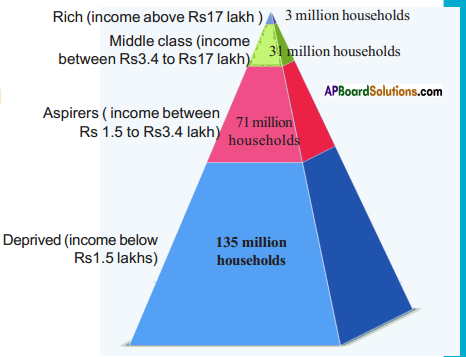

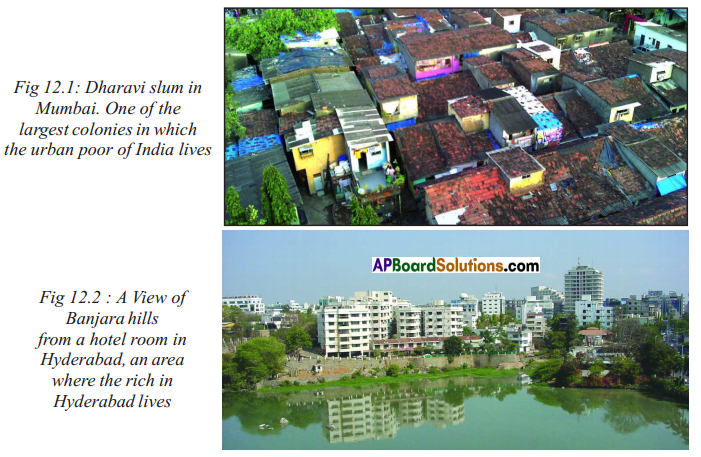 Answer:
Answer:
Graph 1 shows the distribution of households in India based on annual income. It gives the details of rich people, middle class, below middle class and poor people. We can see a lot of difference in terms of inequality. There are 135 million households with annual income Rs. 1.5 lakhs, 71 million households with income between Rs. 1.5 to Rs. 3.4 lakhs, 31 million households with income between Rs. 3.4 to Rs. 17 lakhs whereas 3 million households are there with annual income above Rs. 17 lakhs.
Graph 2 depicts that the total wealth held by Billionaires. When compared to 1996 and 2004, the total wealth by Billionaires had an enormous increase in 2011.
Graph 3 shows an increase in the number of Billionaires. There were 3 billionaires in 1996, 9 billionaires in 2004 but the number of billionaires was 56 in 2011 which shows an enormous increase between 2004 and 2011.
- The figures show the living conditions of the rich and the poor. The rich are getting richer and richer whereas the poor are getting poorer and poorer.
- The rich are leading comfortable lives and the poor are living in pitiable conditions without even basic amenities.
- People with education, skill and wealth have made the best use of opportunities.
- On the other hand, there are many people who have not shared the benefits.
- Such wide inequalities in incomes and opportunities across people cannot be the basis for a just society.
10th Class Social Textbook Page No. 161
![]()
Question 2.
Revisit the class IX chapters on Indian Agriculture and industry.
How have they discussed issues of disparity and distribution and access to resources in these two contexts?
Answer:
- There are disparities in cultivating various crops and areas under such crop cultivation.
- The land distribution was not equitable, more land was concentrated in the hands of large farmers and landlords.
- Small landholdings were there for many small and marginal farmers.
- There were irrigation facilities for only 40% of the total land cultivated.
- When it comes to Industries, we lack in sophisticated technologies and in the adaption of them.
- The capital required did not meet through mobilization and expansions of industries were not in large scale.
- There is shortage of skilled labourers and the wages paid were also low.
- Post globalisation era, changed these situations to some extent of improvement.
Question 3.
Identify how the idea of development has been contested through problems of the environment.
Answer:
- The Idea of development has been contested through problems of environment.
- The ground water levels fell rapidly and ground water recharge is also not to the expected level.
- Fertilizers made the soil less fertile and ever increasing costs to farmers.
- Industrialization has resulted in a world where natural resources are threatened.
- Industrialization has resulted in disruption of climate.
- Economic development focussed narrowly on GDP springs from its neglect of the environment.
- Environmental resources have been used up and damaged to an unprecedented extent.
- There occurred long-term damages to the environment.
Question 4.
What kind of environmental problems did the spread of ‘green revolution’ create? What lesson does this have for the future?
Answer:
- The ‘Green Revolution’ has brought in several environmental imbalances.
- The High Yielding Variety seeds usage required plenty of water.
- The number of tubewells were increased over the years, the groundwater level fell rapidly which meant that less groundwater is available for future use.
- Green Revolution resulted in a loss of soil fertility.
- The soil was deprived of the normal production of micro-organisms.
- Chemical fertilizers polluted groundwater, rivers, lakes, etc.
- Thus, it resulted in ever-increasing costs for farmers.
10th Class Social Textbook Page No. 162
![]()
Question 5.
Why do you think has the modern method of lifting water proved to be unsustainable?
Answer:
- The modern method of lifting water has proved to be unsustainable.
- Initially, there was relief from drudgery, and lifting of water with pumps was easy.
- With the lifting of groundwater by electric and motor pumps, the water table started going down.
- Nearly 1/3 of the country is pumping out groundwater than what goes in as recharge.
- About 300 districts have reported a water level decline of over 4 mts during the past 20 years.
- Groundwaters are also becoming unsafe and being contaminated by chemical industrial waste.
10th Class Social Textbook Page No. 164
Question 6.
The environment is also called ‘natural capital’. Recall the definition of capital from Chapter 9. Why do you think the environment is called natural capital?
Answer:
- Capital from chapter 9 defines as the money needed to meet the inputs of agriculture and the raw materials for production.
- They also included factors of production like land, labour on which money is to be spent.
- Many naturally existing substances like land, water, minerals and ores, products from trees and animals are central to the production processes.
- All the sectors of economy too are dependent on natural resources in various degrees i.e., environment’s source function.
- Thus, we can say that environment is natural capital.
Question 7.
Why should water be considered as common property?
Answer:
- Water is available to us through the nature.
- We can have access to it from different sources like underground water, canals, tanks and rivers, etc.
- It is a compulsory part of living.
- Thus it is common for all and is called common property.
- We shall have it and retain it for the future generations.
- We have used up it and this extra use is causing a concern of future availability.
- Underground waters are to be recharged and we should see that they are not contaminated.
- For a better quality of life to everyone, water is necessary. So water is considered as common property.
Question 8.
Why was it considered necessary to go to court to stop the use of endosulfan?
Answer:
- In 1976, to protect cashew crop the government sprayed the pesticide endosulfan by helicopter over 15,000 acres of land in Kasaragod in the northen part of Kerala.
- The air, water and entire environment was suffused with the pesticide.
- Caused serious health problems to local people, especially agricultural labourers.
- At least 5,000 people died and for countless life became miserable.
- So, it was necessary to go to court to stop the use of endosulfan.
- In recent years, the use of endosulfan was banned by court order.
![]()
Question 9.
The court order banning the use of endosulfan argued that the pesticide violated the Right to Life (Article 21 of the Constitution). Can you describe how use of endosulfan had violated people’s Right to Life?
Answer:
- The Constitution gaurantees Right to Life under Article 21 of it.
- It states that every individual has the right to lead life which is secured.
- But the spraying of pesticide, endosulfan claimed the lives of 5,000 people.
- Apart from this it has caused cancer and deformities which made life worse than death.
- The treatment was continued for 25 years.
- Thus, the use of endosulfan had violated people’s Right to Life.
10th Class Social Textbook Page No. 167
Question 10.
“In the chapter ideas on Development, we read that what is development for one might not be development for another”. Use Bava Mahaiiya’s letter to explain this statement.
Answer:
- Bava Mahaliya in his letter brings out different ideas of development.
- The idea that the government took was different from him.
- Government says their lands were not hospitable but they say they are satisfied with living there.
- As government calls them, they say that they own houses and have prosperous agriculture.
- They have traditional knowledge of every tree and herb and shrub, which would be lost if they are to be dislocated.
- They say they pool together and construct a house in one day and are living alike with sharing a common understanding.
- Thus, we can say ‘what is development for one might not be development for another’.
Question 11.
Create a table identifying the current aspects of living and changes that will occur if the tribal people are re-settled in a different state on the following aspects:
Food habits; Farming; Finance; Relation with forest; Religious practices; House making; Social relations.
Answer:
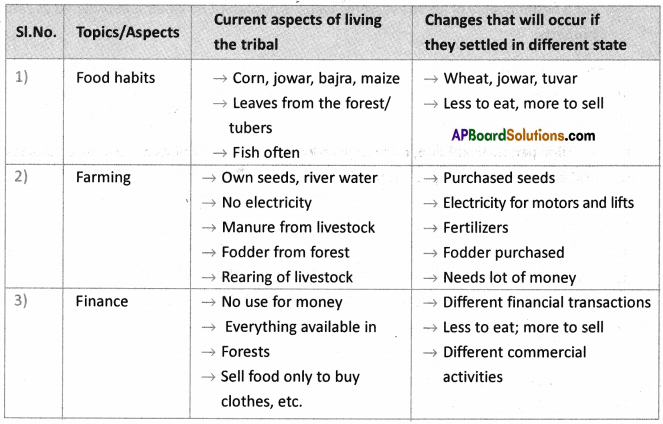

Question 12.
How is the loss of biodiversity being expressed in the letter?
Answer:
- The loss of biodiversity is expressed in different ways in the letter.
- The forest will be submerged and cannot be seen.
- The various trees, shrubs and herbs are not seen and their traditional knowledge will be forgotten.
- Many different kinds of crops that were not grown outside the forest will not be cultivated.
- Channels made from streams will be washed away.
- Thus, the loss of biodiversity was discussed.
![]()
Question 13.
For the tribal people livelihood, cultural practices and social relations are deeply connected to the local environment. Can you explain?
Answer:
- They get their livelihood from local cultivation of own seeds, manure from livestock.
- For irrigation water they make channels from stream in the local environment.
- They live with their clan, their relatives and their kin.
- All of them pool together to any individual’s work needs.
- Their village gods were all there and their ancestors memorial stones were there.
- People come from all over to celebrate their festivals.
- All of them go to market where the youth choose their spouses.
- Thus, tribal people’s livelihood, cultural practices and social relations are deeply connected to the local government.
Question 14.
Do you think that the people of Jalsindhi village are food secure in their present location?
Answer:
- I think the people of Jalsindhi village are not food secure in their present location.
- As far as the various crops they grew, nothing insecure of food.
- They eat the leaves of forest trees like hegva, mahia, amli, etc. It does not refer to food security.
- In times of famine they are survived by eating roots and tubers which is not food secure.
- When they fall sick, their medicine was leaves, roots and bark from forest, this is also not
food secure.
Question 15.
If you lived in the above situation, how would you have responded to the demand for resettlement?
Answer:
- If I lived in the above situation, I would have accepted the demand for resettlement.
- At the place of resettlement, one may get schooling to their children.
- In place of tribal medicine treatments governments provide with public health.
- The food taken there may at times prove to be health hazardous.
- Government pay provide with alternate land to practice modern agriculture, etc.
10th Class Social Textbook Page No. 168
![]()
Question 16. Observe the following figure.
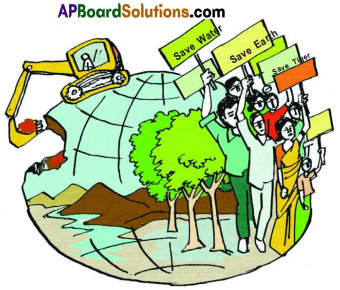 Write your caption in the context of the environment.
Write your caption in the context of the environment.
Answer:
FOR BETTER FUTURE – SAVE THE NATURE
Man is overusing natural resources indiscriminately
Creating severe problems ecologically
For our future generations we should work collectively
To conserve these invaluable resources judiciously
And take measures that are eco-friendly.
10th Class Social Textbook Page No. 169
Question 17.
You have read about the protests against the Kudankulam nuclear power plant in the Chapter on Ideas of Development. Can you interpret the protest in view of what you have read here?
Answer:
- Kudankulam was a peaceful village in Tamil Nadu.
- Most people from there depend on fishing for livelihood.
- With the setting up Kudankulam nuclear power plant all of them have to vacate that place.
- They lost their livelihood.
- Not only they have allayed the fears of the accidents in Nuclear plants.
- A recent accident jn Nuclear plant in Japan created a havoc in the minds of people.
- They have protested on large scale.
Question 18.
“Environment protection is not just crucial for those communities directly affected but for all of us.” Explain with a few examples.
Answer:
- Climate change affects all countries and people, some may be more than the others.
- Even a country is trying to reduce emission of greenhouse gases, its environment would continue to deteriorate if other countries do not regulate their emissions.
- As more and more ground water is pumped out through electric and motor power pumps the water tables deplete.
- In 59% of the districts of India, water from hand pumps and wells are unsafe for drinking.
- Thus, environment protection is not just crucial for those communities directly affected but for ail of us.
![]()
Question 19.
Revisit the class VIII chapters on Mines and Minerals in the context of Andhra Pradesh. What issues of conflict emerge between industrialists and people living in regions of minerals?
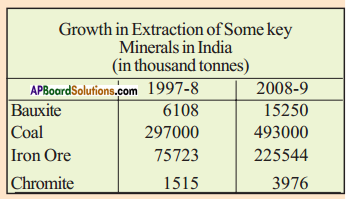 Answer:
Answer:
- People living in regions of minerals face cutting down of forests, destroying fields and habitations, creating large pits and mounds.
- Nearby rivers and water sources are polluted.
- This results in people leaving the land like that as the older use of land cannot be continued.
- Even people who live nearby face problems created by mining.
- Uncontrolled mining by the private companies far in excess of the permits given to them and disregarded safety measures.
- Minerals taken by private companies without paying royalty to the government- thus people do not get anything.
Question 20.
There has been rapid increase in the extraction of minerals for domestic use and for exports to other countries since liberalisation and globalisation of Indian economy. Using figures from the table here substantiate the observation.
Answer:
- The extraction of Bauxite is raised from 6108 thousand tonnes in 1997-98 to 15250 thousand tonnes in 2008-2009.
- The extraction of Coal is raised from 297000 in 1997-98 to 493000 thousand tonnes in 2008-2009.
- The extraction of Iron ore is raised from 75723 in 1997-1998 to 225544 thousand tonnes in 2008-2009.
- The extraction of Chromite is raised from 1515 thousand and tonnes in 1997-1998 to 3976 thousand tonnes in 2008-2009.
Question 21.
What do you think would be the environmental and human costs of such rapid growth in mining?
Answer:
- Such rapid growth in mining would have a negative impact on the environment as well as at the human cost.
- Mines are dug deep, so the layers of earth become weak.
- They may cause landslides, avalanches, earthquakes, etc.
- Most of the water is used in the process of digging and later process also.
- Post liberalisation era brought private people (companies) into mining activities.
- Accidents may occur, tunnel may fall down, or get flooded with water or there can be fire and suffocation due to gases – these dangers may be faced in mining.
- With the motto of earning profits, these companies do not take proper measures of safety.
- Thus, there may be many human losses in rapid extractions of minerals.
10th Class Social Textbook Page No. 170
![]()
Question 22.
Observe the following picture.
 Write your caption in the context of development.
Write your caption in the context of development.
Answer:
On the name of development, man is causing nature’s destruction, So for the flora and fauna where is the protection ?
Project work
![]()
You have read about composting in the context of organic farming. Here is a simple method that you can try out in your school and home.
- Take a large size container and make several holes for water drainage.
- Layer it with coconut fibres for drainage.
- Cover it with a thin layer of soil.
- Add vegetable wastes in a layer.
- Add another layer of soil.
- Again add vegetable wastes in a layer.
- Cover with soil.
- After one week, introduce earthworms in it.
- After decomposition, use the soil to make a small garden with plants of your choice.
Answer:
Self Activity.